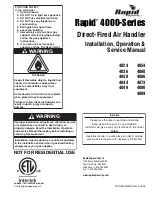
YORK INTERNATIONAL
22
Installation
FIG. 22 –
DRAIN TRAP SHOWING WATER
LOCATION DURING DRAW THROUGH
OPERATION STAGES
FIG. 23 –
DRAIN TRAP PIPING FOR
DRAW-THROUGH UNIT
LD06342
LD06343
FIG. 21 –
TYPICAL DX COIL PIPING
LD06341
The venturi distributor furnished with YORK DX coils
is suitable for field application of a hot gas bypass valve.
The connection may be made through a tee installed in
the field between the expansion valve and distributor.
The system balance point and control adjustments must
assure compressor cooling and avoid excessive com-
pressor cycling. Performance data has been provided
for DX coils utilizing Refrigerant 22. Contact the fac-
tory for specific application information for refrigerants
other than R-22.
AIR VELOCITY THROUGH COILS
The air velocity flowing through chilled water and di-
rect expansion coils must not exceed specific recom-
mended values, to prevent carryover. Air velocity which
is too low will result in a low load situation on the cool-
ing coil which will affect compressor operation. Air-
flow (CFM) and velocity (FPM) can be adjusted by
changing fan pulley sizes and/or S.P.
CONDENSATE DRAIN PIPING
The majority of cooling coils are located in the units so
that the supply air is drawn through them. This results
in the condensate being subjected to negative (-) static
pressure. Unless some means of pressure equalization
is provided in the condensate drain, the air rushing back
through the drain pipe will cause the condensate to build
up in the drain pan. As the unit continues to operate,
the accumulated water will be carried with the air
stream, overfilling the drain pan causing possible water
leaks into the supply duct and/or causing water damage
in the building. A trap must be installed to prevent this
condensate water build-up. (See Figures 22 and 23) On
initial startup, it may be necessary to fill the trap manu-
ally or, after the unit has operated sufficiently for a small
amount of condensate to collect in the drain pan, turn
off the unit, and the trap will automatically fill.
CONDENSATE DRAIN TRAP
Install a trapped condensate drain line at unit drain con-
nection (See Figure 23) according to all governing codes.
“H” dimension must be at least 1/2 inch greater than
negative pressure (I.W.G.) in unit drain pan. To deter-
mine “H” dimension, first determine the negative static
pressure in the unit. Always assume the worst condi-
tions, such as dirty filters in the return air circuit to fan.












































